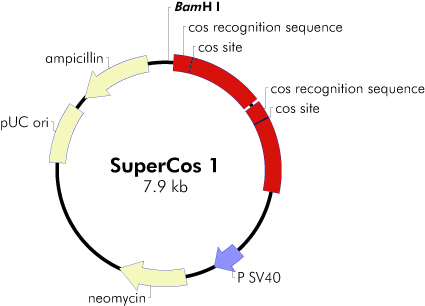


So a cosmid clone is simply a 35–50 kb plasmid which can be efficiently packaged into bacteriophage lambda particles and injected into E. coli cell, the cosmid is replicated through its plasmid replication system and cells containing the cosmid clone are selected by the antibiotic resistance marker in the vector. Once the phage particle containing the cosmid clone injects its DNA into an E. As a result, cosmids can generally accept 30–40 kb insert fragments. Since the plasmid does not require the lambda genes necessary to form progeny phage particles on infection, there is more capacity in the cosmid for containing insert DNA than with a bacteriophage lambda vector. All that is required for this to occur is for the plasmid to contain the lambda cos DNA sequence. Feldblyum, in Encyclopedia of Genetics, 2001 Cosmid VectorsĬosmid vectors are plasmids that can be packaged into infectious bacteriophage lambda particles via the lambda in vitro packaging system. “Genomic Library Construction” By Aluquette – Own work (CC BY-SA 3.W.C. “Plasmid (english)” By User:Spaully on English wikipedia – Own work (CC BY-SA 2.5) via Commons WikimediaĢ. “Cloning Vector.” Cloning Vector – an Overview | ScienceDirect Topics, Available here. “DNA Cloning with Plasmid Vectors.” Molecular Cell Biology. Thus, this is the summary of the difference between plasmid and vector. Moreover, they contain genes that provide some benefit to the host cell. The speciality of the plasmids is that they can self replicate. They are small molecules ranging from a few thousand base pairs to more than 100 kilobases (kb). In fact, plasmids are circular, double-stranded DNA molecules that are extrachromosomal DNA occurring naturally in bacteria. Plasmids are popular as vectors than the other vectors in recombinant DNA technology. There are several types of vectors such as plasmids, cosmids, artificial chromosomes, bacteriophages, etc. So it works as a vehicle between the host and the donor. Vector is a small DNA molecule that carries foreign DNA into the host cell. Moreover, a further difference between plasmid and vector is that the plasmids are naturally occurring in bacteria and other organisms, but some vectors are natural while some are artificially synthesized.īelow infographic summarizes the difference between plasmid and vector. So, this is the key difference between plasmid and vector. Whereas, a vector is a small DNA molecule that acts as a vehicle to deliver foreign DNA from donor to host. They are small double-stranded circular DNA molecules. What is the Difference Between Plasmid and Vector?Ī plasmid is an extrachromosomal DNA of bacteria, yeasts, archaea and protozoa. Moreover, it is possible to manipulate them easily.Furthermore, they possess antibiotic-resistant genes, etc that work as markers.Also, they can carry a foreign DNA fragment to the host cell.Both plasmid and vector have the ability to self replicate.What are the Similarities Between Plasmid and Vector? But these genes give extra survival to bacteria. These are not essential for the functioning of bacteria, where they reside. Plasmid size can be varied from less than 1.0 kb to more than 200 kb, but the number of plasmids in a cell is a constant from generation to generation. Furthermore, this small DNA possesses several genes, but a lesser when compared to bacterial chromosomal DNA. Side by Side Comparison – Plasmid vs Vector in Tabular FormĪ plasmid is a small circular DNA element of bacteria. Similarities Between Plasmid and Vectorĥ.

Mostly, the host organism may be a bacterium such as Escherichia coli (E. Plasmids are a type of popular vectors in genetic engineering. Moreover, it should possess several qualities such as self-replication, small genome, expression within the host, bearing markers, etc. Thus, a vector is a DNA molecule that carries foreign genetic material into another cell. Hence, in order to deliver foreign DNA into the host cell, genetic engineering uses a vehicle called a vector. Therefore, it needs additional self-replicating DNA to combine with it. Most DNA fragments cannot be self-replicated in another host cell. Genetic engineering is a novel field of Biotechnology which deals with transferring of foreign DNA to selected hosts and allowing them to duplicate within the host cell. The key difference between plasmid and vector is that plasmid is a type of vector and is a circular, double-stranded extra-chromosomal DNA molecule of some bacterial species while vector is a self-replicating DNA molecule that acts as a vehicle for delivering foreign DNA into host cells.


 0 kommentar(er)
0 kommentar(er)
